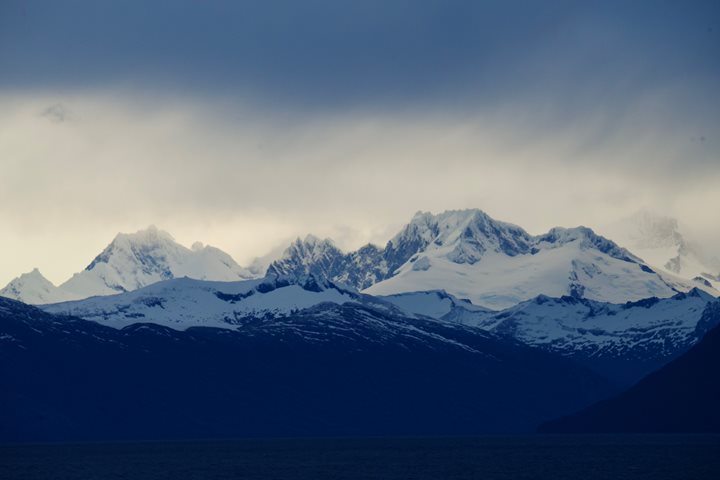An early departure from Puerto Natales port leaves behind memories of the amazing National Park Torres del Paine and its multicolored lakes, glaciers, fantastic peaks, gracile guanacos, rheas, and a gratifying lamb barbecue at Rio Serrano Lodge.
Towards the stern: Puerto Natales and the huge Almirante Montt Gulf and its many long, no-exit fjords: i.e. Poca Esperanza, Obstruccion, Ultima Esperanza, and others. Towards the bow, gusting winds, white crested waves. Five knot currents at the Kirke Narrows requires a rapid decision from the experienced Captain and Chilean pilots to sail through this challenging waterway. In doing so they avoid increasing winds and currents, and consequently hours of waiting for slack waters. It is indeed one of the most difficult passages along the 1500 km (ca.780 nm) of the Chilean fjords. Finding and passing this narrows (i.e.110 m wide and 15 m deep) or the White Narrow (i.e. 60 m wide, 60 m deep), as the only ways out of the intricate Almirante Montt Gulf, must have demanded an amazing talent and determination from early navigators, who adventured here with their sailing ships and crew in search of easier ways to avoid the even rougher Pacific waters.
Thick, light green Notophagus (southern beech) forests and waterfalls cover the almost vertical walls of the narrows. Plenty of birds saluted the National Geographic Explorer as she went through: gentle kelp geese on the coastline, giant petrels, imperial shags, black-browed albatross defying the gusting winds and waves.
Dark skies, rain, winds, and waves dominate outside; within there is warmth, a relaxing and friendly atmosphere on the bridge and the library. In the lounge, naturalist Santiago Imberti talked about the hooded grebe project and successful efforts to create the Patagonian National Park in Argentina, a counterpart to the Chilean Patagonian National Park.
In the early afternoon we went through other narrow passages on our way to the Strait of Magellan and Seno Almirantazgo. Impressive wrecks like Leonor off Muñoz Gamero Island, which occurred when the Captain was casually talking to an assistant on the bridge. He agreed by saying “Alright,” and the man at the helm obeyed by turning it “all the way to the right,” and so we now have this famous shipwreck.
The evening continued with Kike Calvo’s talk on tips for photo portraits, followed by guest speaker Melissa Carmody, a Wildlife Conservation Society representative, who spoke on the challenges of the Karukinka Nature Reserve. We all survived the choppy waters of the Pacific Ocean before entering the Magellan Strait.







